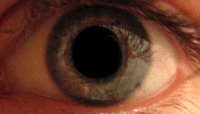Task-invoked pupillary response

Have you ever noticed how your eyes get bigger or smaller depending on what you're doing? When you look at something really interesting, like a cool toy or a yummy snack, your eyes might get bigger. And when you're sleepy, your eyes might get smaller. This is because of something called a pupillary response - your pupil is the black part of your eye and it gets bigger or smaller depending on how much light is coming in.
But there's another type of pupillary response called a task-invoked pupillary response that happens when you're doing something that requires a lot of brain power. When you're working on a challenging puzzle or trying to read a book with big words, your eyes might get bigger too! This is because your brain is working really hard to figure things out, and needs more light to do it.
Scientists use pupillary responses to learn more about how our brains work. They can measure how big our pupils get during different tasks to understand which parts of our brain are being used the most. Just like how different parts of the body work harder during certain activities - like your legs during a race or your arms during a game of catch - different parts of the brain work harder during different tasks. And our pupils can help scientists figure out which parts of the brain are working the hardest!
But there's another type of pupillary response called a task-invoked pupillary response that happens when you're doing something that requires a lot of brain power. When you're working on a challenging puzzle or trying to read a book with big words, your eyes might get bigger too! This is because your brain is working really hard to figure things out, and needs more light to do it.
Scientists use pupillary responses to learn more about how our brains work. They can measure how big our pupils get during different tasks to understand which parts of our brain are being used the most. Just like how different parts of the body work harder during certain activities - like your legs during a race or your arms during a game of catch - different parts of the brain work harder during different tasks. And our pupils can help scientists figure out which parts of the brain are working the hardest!
Related topics others have asked about:
